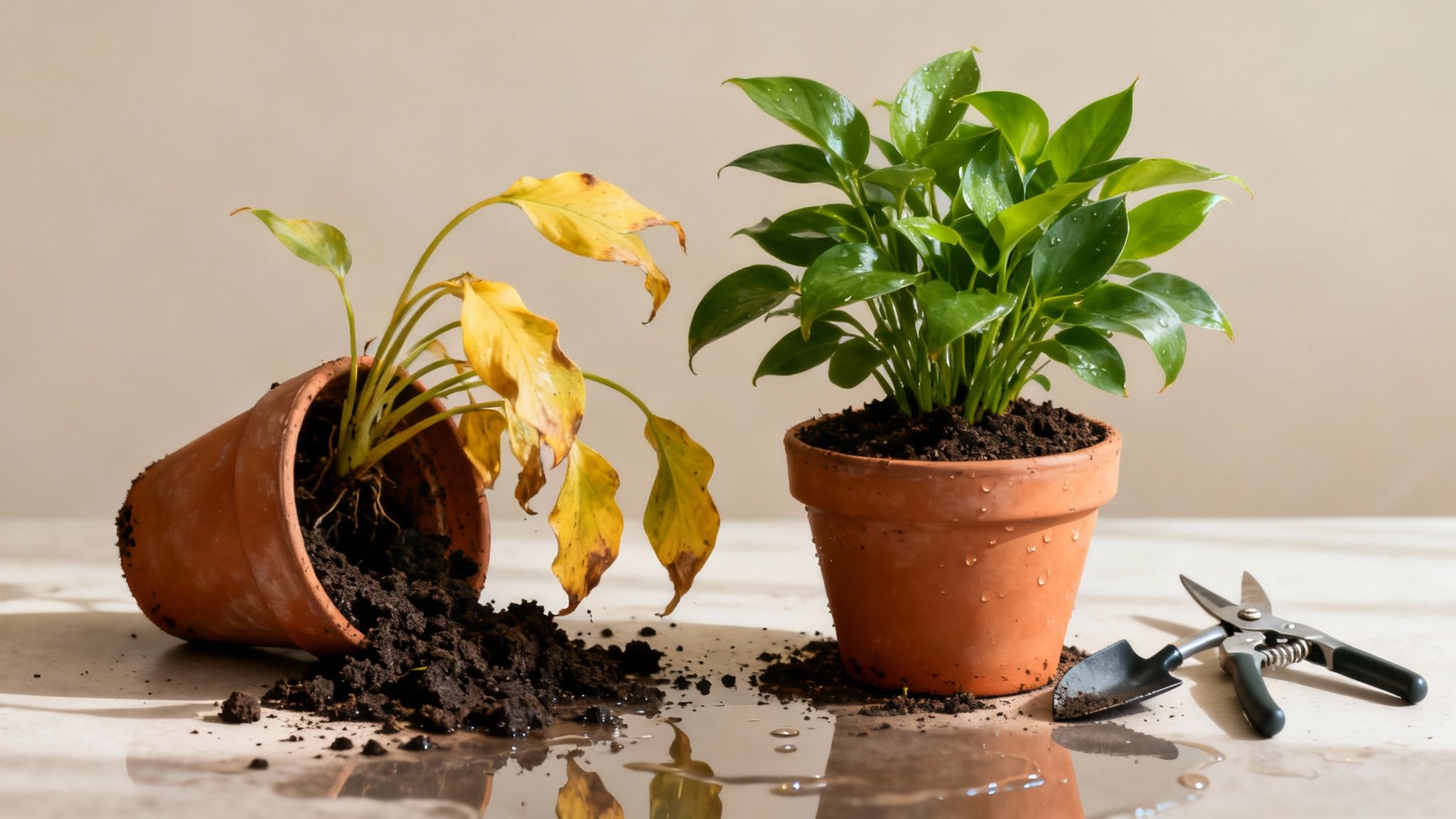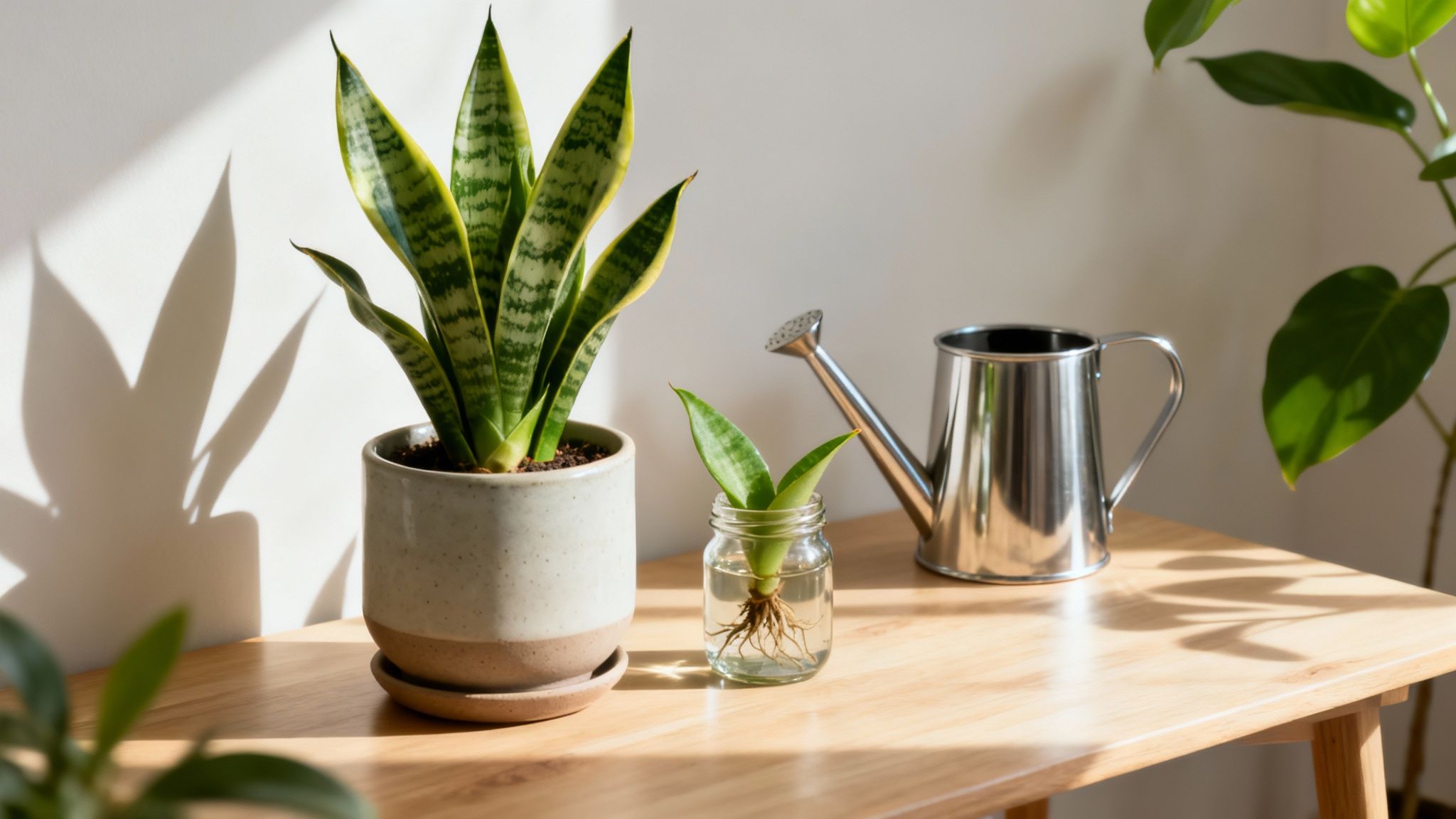You walk over to admire your favorite houseplant and spot it: a fuzzy, white layer blanketing the topsoil. Don't panic! This is one of the most common issues plant parents face, and thankfully, the fix is usually straightforward. While seeing mold can be alarming, it's really just a signal from your plant that its environment needs a little tweak.
This guide will walk you through exactly what that white stuff is, how to get rid of it safely, and most importantly, how to adjust your care routine to keep it from coming back. You'll learn the simple, effective steps to ensure your plant's soil is a healthy, thriving foundation, not a breeding ground for fungus. Let's dig in and turn this fuzzy problem into a distant memory.
What Is That White Stuff On Your Plant Soil?
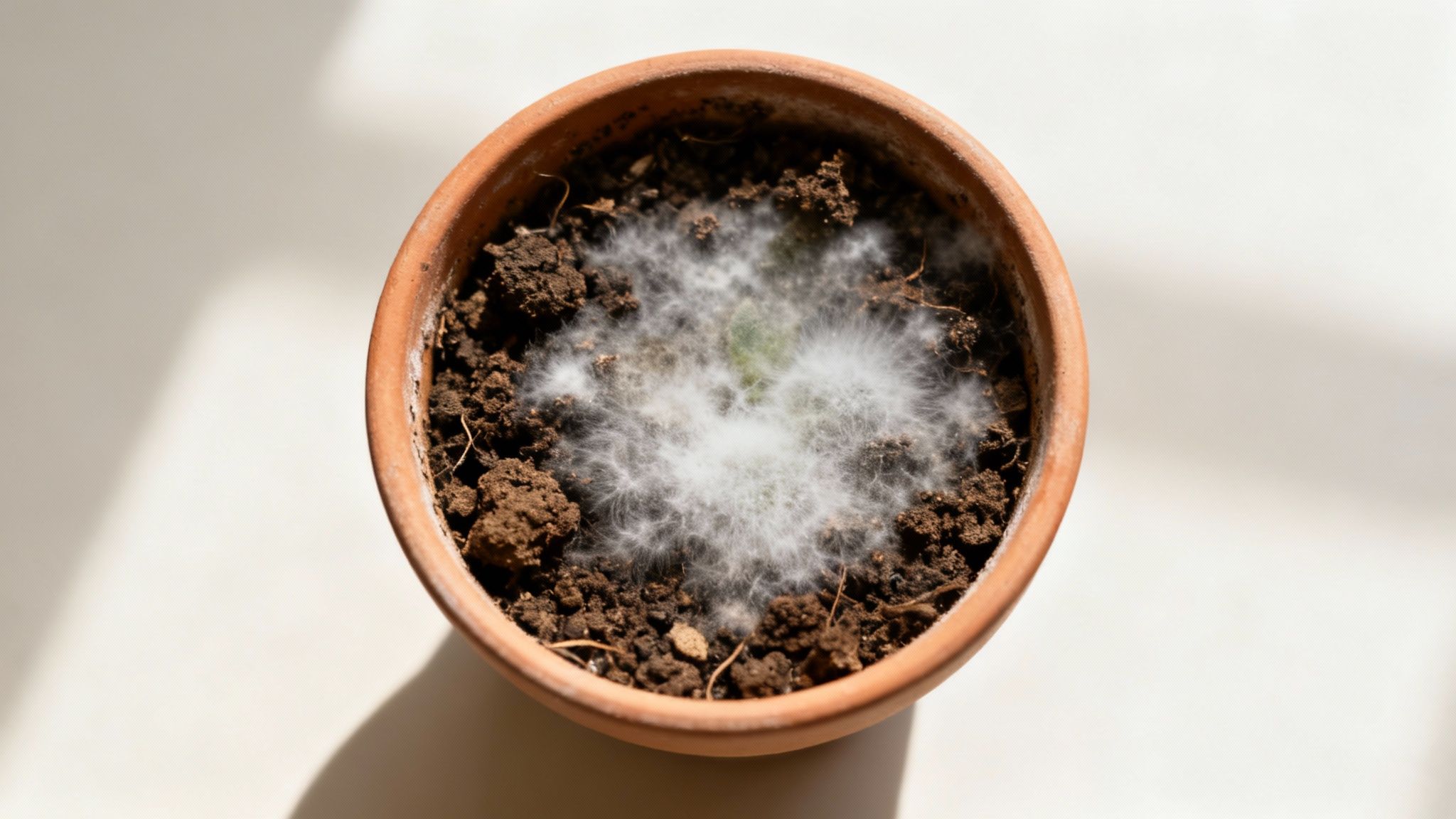
So, what exactly is that fuzzy white stuff? It’s almost always a harmless saprophytic fungus. Think of it as nature's little cleanup crew. These fungi show up to feast on the decaying organic material found in most potting mixes. Did you know there are over 1.5 million species of fungi, and most of them are beneficial decomposers?
While this type of mold typically won't harm your plant directly, its presence is a big, flashing sign that your plant's environment isn't quite right. Seeing this mold is less of an emergency and more of a clue. It’s your plant telling you that something needs to be adjusted. Getting to the bottom of these causes is the key to not just removing the mold but keeping it from ever coming back.
Key Causes of Soil Mold
- Excessive Moisture: This is the number one offender. Overwatering creates a constantly damp environment, which is an open invitation for fungal spores to move in and thrive.
- Poor Air Circulation: Stagnant air is another culprit. When there’s no breeze, humidity hangs around the soil's surface, keeping it moist and encouraging mold growth. This is a common issue for plants tucked away in corners or crowded together.
- Low Light: Dark spots don't get enough sun to help the soil dry out properly between waterings. This prolongs the damp conditions that mold adores.
- Organic Debris: Fallen leaves or spent flowers on the soil surface become a buffet for saprophytic fungi, encouraging them to multiply.
Spotting this mold is an opportunity to fine-tune your plant care routine. Here at Tendra, we believe that paying attention to these small signals is what elevates your gardening game. When you're unsure if you're dealing with harmless mold or a more serious plant disease, Tendra's AI disease diagnosis can provide quick clarity. A few simple tweaks can lead to a lifetime of health for your green friends.
Identifying the Root Cause of Soil Mold
Before you can get rid of that fuzzy white mold on your plant's soil, you have to play detective. Just scraping it off is a temporary fix. If you don't figure out why it showed up, it's just going to come right back. Think of the mold as a symptom—the real problem is hiding in your plant's environment or your care routine.
The good news? The culprits are almost always easy to spot and fix. Let's dig into the three most common reasons you're seeing mold.
The Problem of Excess Moisture
Overwatering is the primary cause of soil mold. When soil stays soggy, it becomes the perfect breeding ground for fungal spores. This isn't just about watering too often; poor pot drainage is a huge part of the problem.
If your pot doesn't have adequate drainage holes, or if it sits in a saucer full of water, the soil never gets a chance to breathe. This waterlogged condition is a welcome mat for mold. According to EPA guidelines, controlling moisture is critical, since mold can't grow without it. Once soil stays wet for more than 48 hours, those spores have the perfect conditions to sprout. You can explore the EPA's findings on moisture and mold control for a deeper dive.
Stagnant Air and Low Light
Mold loves still, humid air. Is your plant tucked away in a cramped corner or a room with poor airflow? When the air around the soil surface doesn't move, moisture gets trapped instead of evaporating, keeping the topsoil damp for much longer than it should be.
Low light makes this situation even worse. A plant in a dark spot doesn't use water as quickly, and without sunlight, the soil surface never really gets a chance to dry out. It’s a perfect storm for fungal growth.
Practical Tip: Even a small, oscillating fan set on low for an hour a day can work wonders. It dramatically improves air circulation around your plants, making the environment much less hospitable for mold.
Imbalanced Soil Environment
See that fallen leaf just sitting on the soil? To you, it’s harmless. To mold, it's an all-you-can-eat buffet. The specific type of fungi we're talking about (saprophytic fungi) feeds on decaying organic matter. While potting mixes are full of organic material by design, adding extra fuel to the fire with fallen leaves or spent blooms gives mold an open invitation.
An imbalanced soil environment can also play a role. While it's not a direct cause of this kind of surface mold, understanding your soil's health is key to preventing all sorts of issues. You can learn more by checking out our guide to mastering soil pH.
A Step-by-Step Guide to Removing Mold From Plant Soil
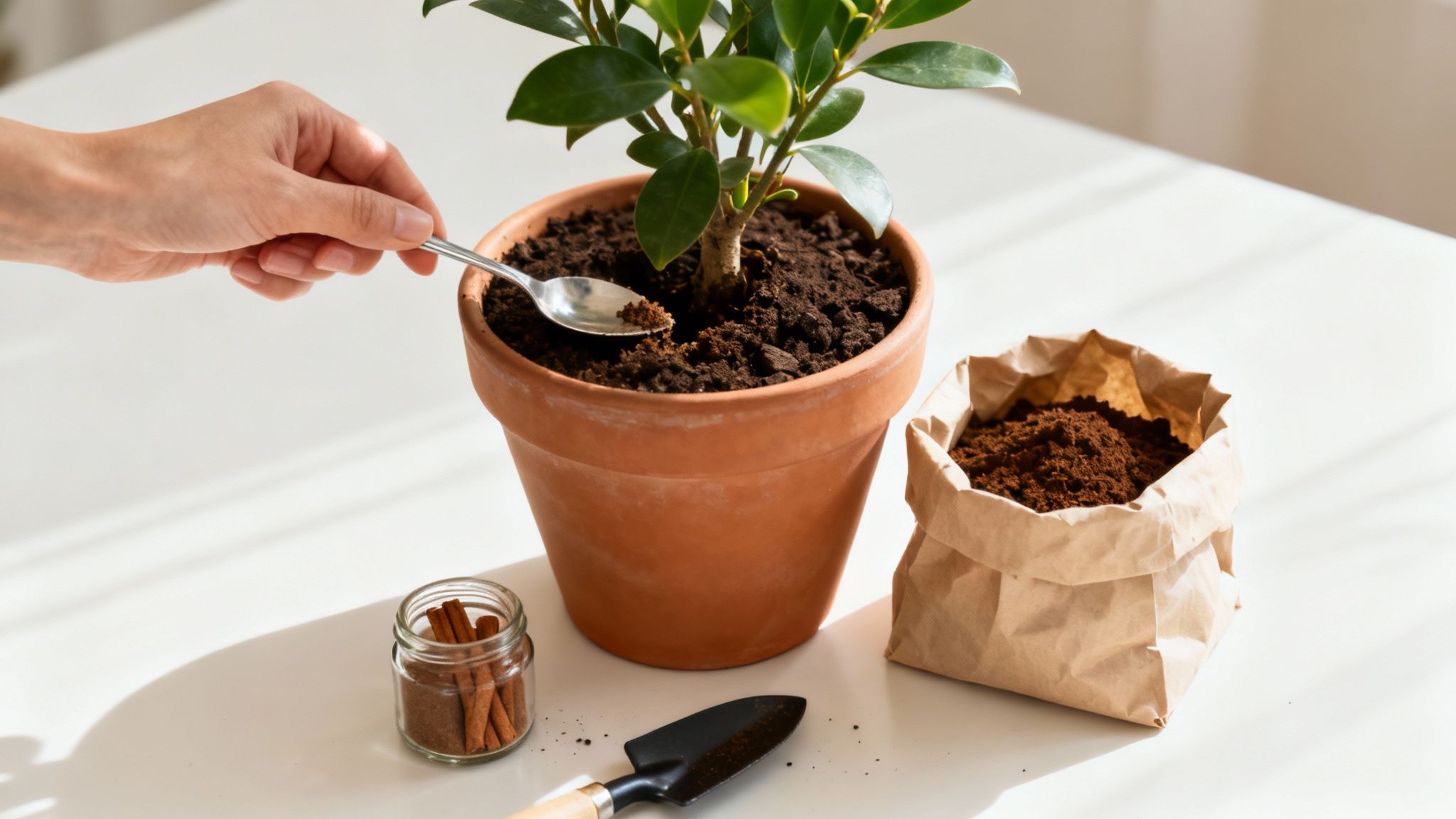
Alright, you've figured out why the mold showed up. Now it’s time to deal with it. The good news is you don’t need harsh chemicals—a few things you already have at home will work perfectly.
Your first step is the most direct: just get rid of it. Grab a spoon or a small trowel and gently scrape off the top 0.5 to 1 inch (about 1-2.5 cm) of soil. This is where the mold is actually living, so removing this layer tackles the immediate problem head-on. Try to be delicate, especially with plants that have shallow roots. Once you've scooped out all the moldy bits, seal them in a bag and toss it in your outdoor trash to prevent spores from spreading.
Treat the Soil with a Natural Fungicide
With the visible mold gone, the next move is to treat the freshly exposed soil to knock out any lingering spores. You likely have a few natural fungicides right in your kitchen pantry that are safe for your plants and home.
Here are three practical, go-to methods for treating the soil:
- A Dash of Cinnamon: It might sound strange, but ground cinnamon is a fantastic natural fungicide. Just sprinkle a light, even layer over the top of the soil. It smells amazing and does a great job of stopping fungal growth without hurting your plant.
- Hydrogen Peroxide Solution: For a bit more punch, grab a bottle of standard 3% hydrogen peroxide from your first-aid kit. Mix one part hydrogen peroxide with four parts water in a spray bottle. Give the soil surface a light mist—you’ll see it fizz a little as it works, killing spores on contact.
- Baking Soda Spray: This is another simple and effective option. Mix one teaspoon of baking soda into a quart (or a liter) of water. A light spray on the soil surface changes its pH level just enough to make it an unfriendly place for mold to grow.
Editor's Note: You're not trying to completely sterilize the soil. The goal is just to get things back in balance. These gentle treatments target the surface mold without wiping out all the beneficial microbes doing their thing deeper in the pot.
Picking one of these simple treatments gives your plant a clean slate. This is exactly how to remove mold from plant soil without a fuss, letting you solve the problem the moment you spot it.
Creating a Mold-Resistant Environment for Your Plants
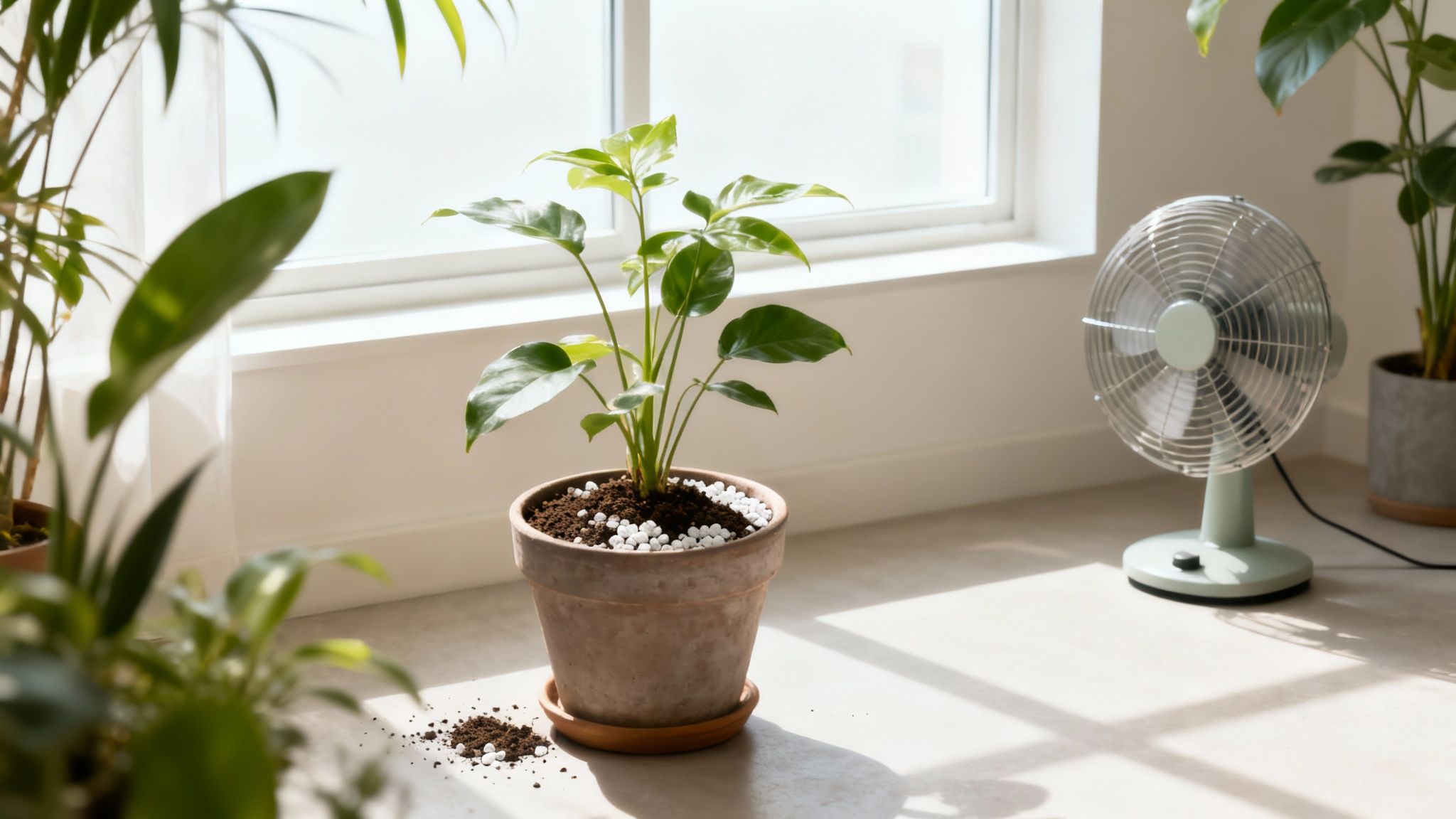
Scraping off that fuzzy white mold is satisfying, but the real win is making your plant’s pot an unwelcome place for it to ever grow again. This is where proactive care comes in.
It's all about small, consistent habits. By dialing in just four key things—watering, airflow, light, and soil—you can create a mold-free future for your green friends. This is how you stop the problem before it even starts.
Master Your Watering and Airflow
If you take away one thing, let it be this: master your watering technique. Instead of watering on a strict schedule, check the soil first.
A simple way is the finger test: stick your finger about 2 inches (5 cm) into the soil. If it feels dry, it's time for a drink. If it’s still damp, wait another day or two. Another great technique is bottom watering. Simply set the pot in a tray of water for 20-30 minutes and let the soil soak it up from the bottom. This keeps the top layer of soil dry—which mold hates—and encourages stronger root growth.
Airflow is the other side of that coin. Stagnant, humid air is a welcome mat for mold.
- Give Them Space: Don't cram your plants together. Leaving a bit of room lets air move freely.
- Use a Fan: In a stuffy room, a small fan on low for an hour a day makes a world of difference for air circulation.
Optimize Light and Soil Composition
Sunlight isn't just for photosynthesis; it’s a natural sterilizer that helps soil dry out evenly. Ensure your plant is getting the right amount of light for its species. A plant struggling in a dark corner will hold onto moisture for too long.
Your soil choice is just as crucial. A heavy, dense potting mix that holds water like a sponge is asking for trouble. When it's time to repot, choose a mix designed for good drainage. I almost always amend my soil with a handful of perlite or coarse sand to boost aeration. This lets the roots breathe and prevents waterlogging.
A Proactive Approach: The key to preventing mold is consistency. Forgetting to water and then flooding the plant creates a cycle of stress and moisture imbalance. Tendra’s Smart Care Reminders can help by creating a personalized schedule based on your specific plant’s needs, removing the guesswork entirely.
It’s also worth noting that a healthy soil microbiome—full of beneficial microbes—can outcompete harmful fungi all on its own. For instance, studies on leaf mold compost have shown it can boost soil microbial diversity by a staggering 60%, which actively suppressed pathogens in tomato plants. You can learn more about how soil treatments impact plant health and see why building a rich soil ecosystem is such a powerful, science-backed strategy.
Real-World Application: A Fiddle Leaf Fig Story
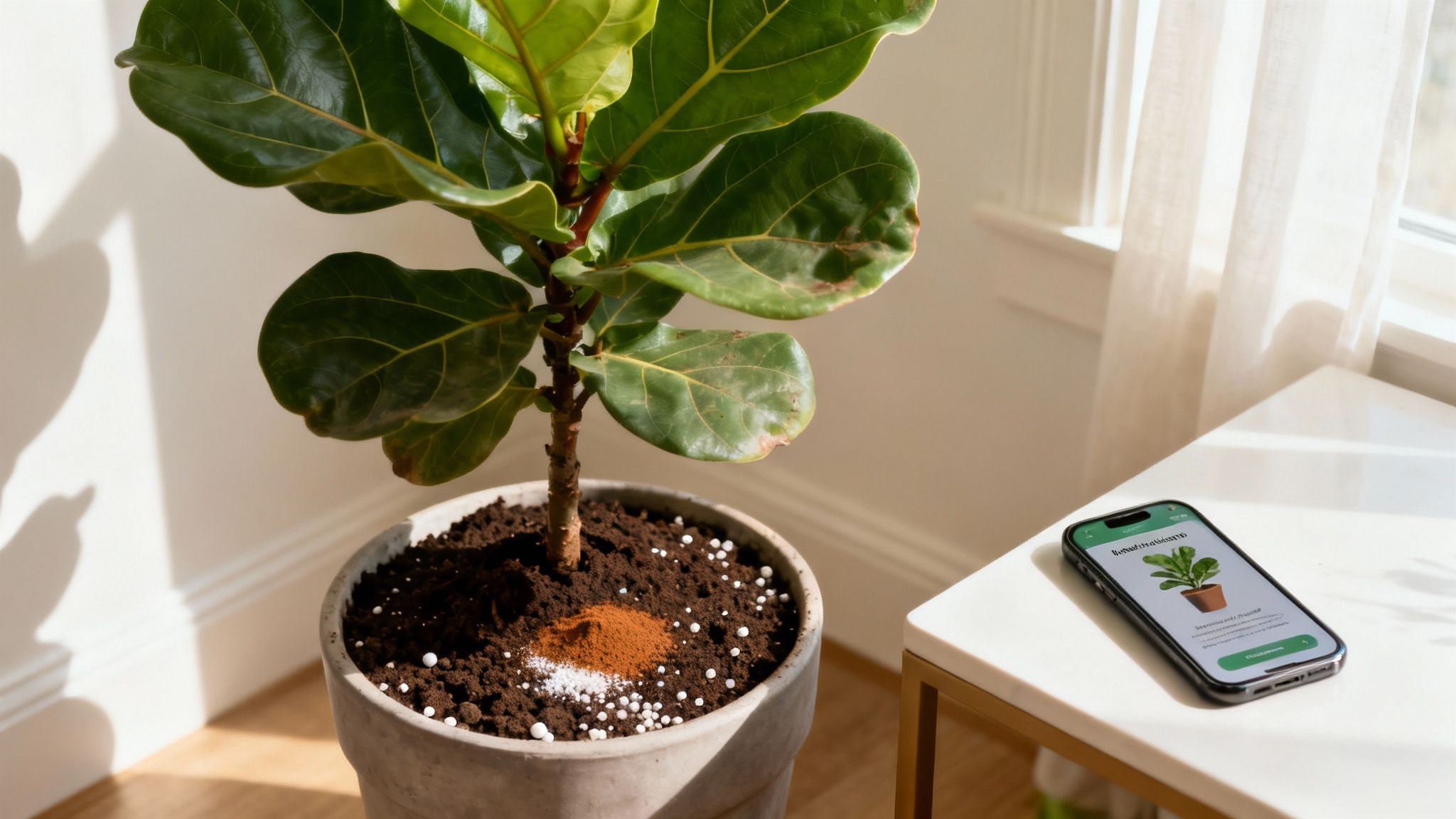
Let's walk through a real-world scenario. It’s one thing to read about these steps, but it’s another to see how they play out when you’re staring at a fuzzy patch on your prized plant.
Meet Sarah from Portland, a new plant parent who was dealing with a stubborn white fuzz on her beautiful Fiddle Leaf Fig (Ficus lyrata). The problem cropped up after a particularly gloomy, sunless week. She’d been sticking to a rigid weekly watering schedule, not realizing the cool, overcast weather meant the soil just wasn't getting a chance to dry out.
Following the advice in this guide, Sarah scraped off the top inch of soil and gave the surface a light sprinkle of cinnamon. But the quick fix wasn't the real solution. The mold was a symptom, and she needed to treat the cause. The true fix came from adjusting her routine. She moved her Fiddle Leaf to a brighter spot and ditched the schedule, instead only watering when the top 2 inches (5 cm) of soil actually felt dry.
The real game-changer for Sarah was connecting with a local gardener through Tendra’s Twin Plant Mates feature. She was matched with another Fiddle Leaf Fig owner in her area who shared a fantastic tip: add more perlite to the soil mix during the next repot. This simple change dramatically improved aeration and drainage. You can discover more specific care tips for Fiddle Leaf Figs in our extensive plant database.
Fast forward two months, and Sarah's plant is healthier than ever—and completely mold-free. It’s a perfect example of how combining practical steps with a little community wisdom leads to a thriving plant.
Your Top Questions About Soil Mold Answered
Even after you've dealt with the fuzzy stuff, a few questions usually pop up. Let's clear the air on some of the most common worries gardeners have when they spot that white fuzz.
Is This Mold Harmful to Me or My Pets?
For the most part, the common white mold you see on houseplant soil (saprophytic fungus) is harmless to people and pets. It's really just interested in munching on the decaying organic bits in the soil. That said, if you or someone in your house has severe mold allergies or a compromised immune system, it's a good idea to be cautious as airborne spores could potentially cause a reaction.
Is It Mold or Something Else?
Before you act, make sure you're actually looking at mold. Sometimes, what you see is efflorescence, a crusty, white buildup of mineral salts from your tap water. It’s completely harmless.
Here’s the quick way to tell them apart:
- Mold is soft, fluffy, and looks a bit like a spiderweb. It often has a distinct musty, damp smell.
- Efflorescence is hard, crystalline, and scrapes off easily. It has no smell.
What if the Mold Comes Back?
So, you've improved the airflow and cut back on watering, but the mold keeps returning. This is a classic sign that there's a deeper issue with the soil itself. It likely means your soil is too dense and holding onto water, or it lacks the beneficial microbes that keep fungi in check. Research has shown that some fungicides can leave viable spores behind, which just wait for the right conditions to spring back to life. You can discover more about modern microbial-based solutions that tackle the root of the problem.
If you’re dealing with a really stubborn case, your best bet is to repot the plant entirely with fresh, well-draining soil.
Dealing with soil mold is a valuable learning experience on your plant care journey. By understanding the "why" behind the fuzz, you’re not just solving one problem—you're learning how to create a healthier home for all your plants. Mastering how to remove mold from plant soil is about balancing moisture, light, and air to build a resilient, thriving indoor garden.
Ready to connect with gardeners who have solved this exact problem? Discover your plant's local growing partners with Tendra—where gardeners connect, grow, and share.





